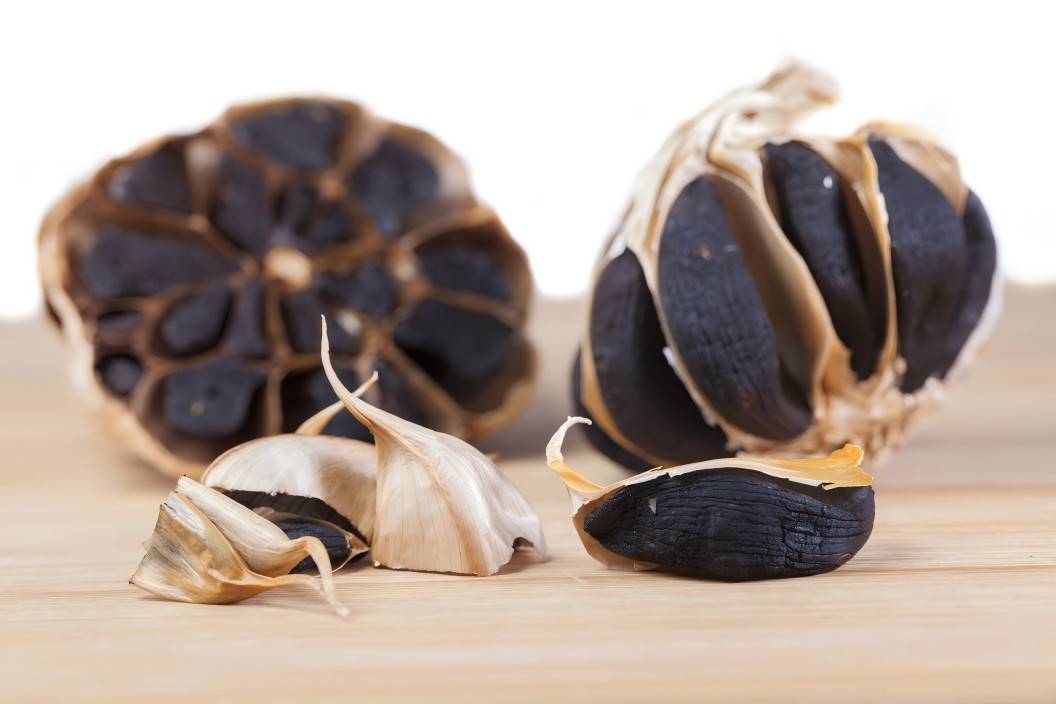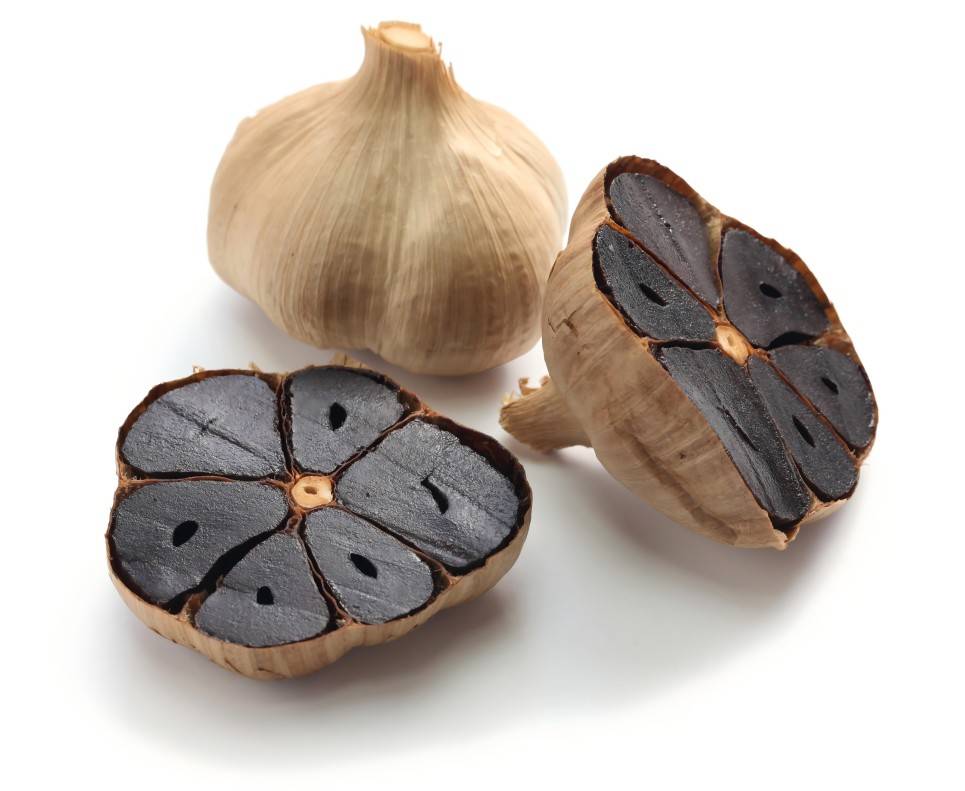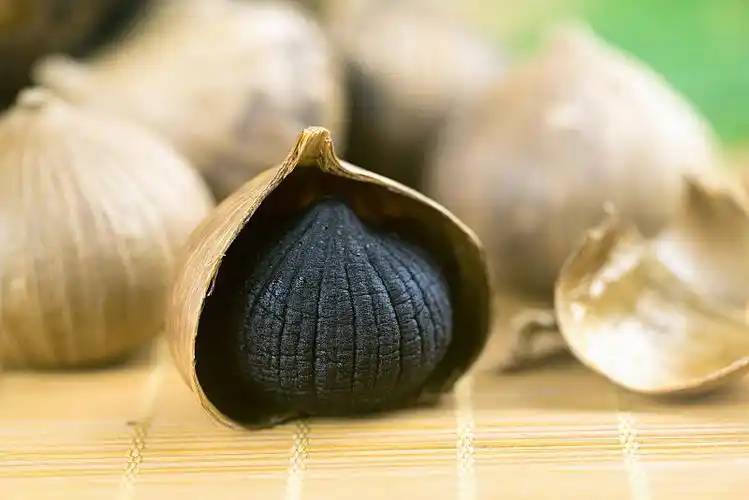How About the Nutritional Value of Black Garlic?
Black garlic, also known as fermented black garlic, is made by fermenting fresh raw garlic with the skin on in a high-temperature, high-humidity fermentation box for 60 to 90 days to allow natural fermentation. Since the entire garlic clove turns black after fermentation, it is called black garlic. Garlic (Allium sativum L.) is the underground bulb of a perennial herb in the family Alliaceae. It has a pungent taste and warm nature, entering the lungs, spleen, and heart meridians. It has antibacterial, anti-inflammatory, wind-dispelling, antidiarrheal, and anti-abscess effects. Garlic is used to lower cholesterol levels and the risk of cardiovascular disease. It also has antibacterial and anti-inflammatory properties, prevents and treats cancer, strengthens the immune system, anti-aging and other functions1-2. Black garlic has removed the peculiar smell of garlic, has a sweet taste and a good texture, and can be eaten directly without further processing. Therefore, compared with white garlic, it is more nutritious, has enhanced biological activity and better application prospects. This article mainly summarizes the nutritional value, chemical composition and biological function of black garlic, and provides a summary and outlook.
1 Comparison of the nutritional value of black garlic and garlic
Black garlic has extremely high nutritional value, and its nutrients are shown in Table 113. As can be seen from Table 1, compared with garlic, black garlic has significantly lower moisture and fat content, and significantly higher trace element content. The highest trace element content in black garlic is potassium, followed by magnesium, sodium, calcium, iron and zinc, which are all important for maintaining human life activities. These are all essential nutrients for the human body. The levels of proteins, sugars and vitamins are at least twice as high as in regular garlic. The amino acid content, which is an important flavour component, is 2.5 times higher in black garlic than in regular garlic. Black garlic contains a wide range of nutrients, including amino acids, peptides, proteins, enzymes, glycosides, vitamins, fats, minerals, carbohydrates and sulphur-containing compounds. The main vitamins in black garlic are the B vitamins.
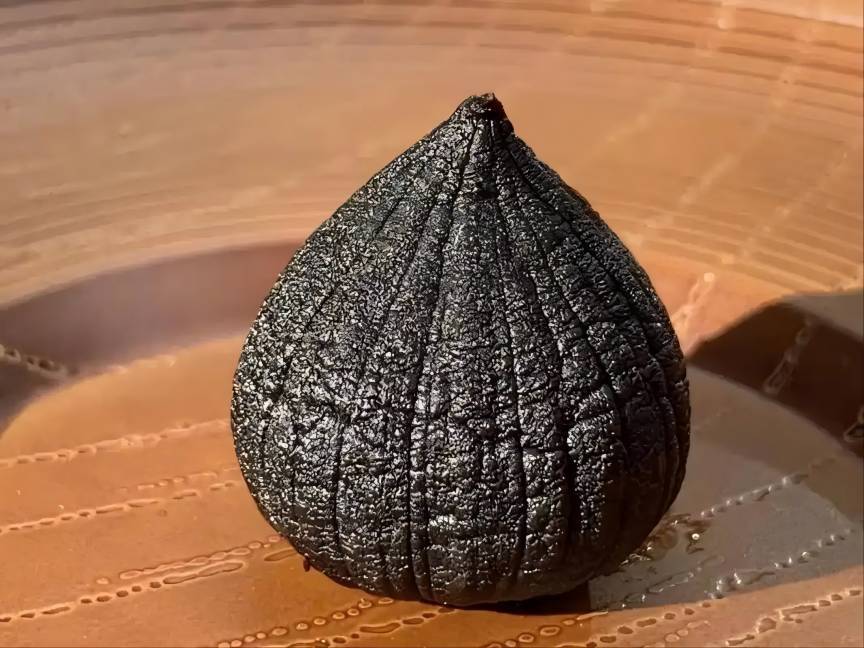
In addition to allicin, amino acids and vitamins, black garlic also contains reducing sugars (mainly glucose and fructose), sucrose and polysaccharides. It has been reported that black garlic, which is made by fermenting ordinary garlic, retains the original ingredients of raw garlic while increasing its antioxidant and anti-oxidation effects by dozens of times. It also converts a large amount of the protein in raw garlic into the 18 essential amino acids that the human body needs every day, which are quickly absorbed by the body. It also has higher antioxidant activity than ordinary garlic, which has a huge positive effect on strengthening the body's immune system, recovering from fatigue, play a huge positive role in maintaining human health. It is also a fast-acting health food with a sweet and sour taste, no garlic smell after eating, and does not cause internal heat. Therefore, black garlic is rich in essential nutrients that are even capable of improving bodily functions, and has extremely high nutritional value.
2 Chemical composition of black garlic
Modern medical research has confirmed that garlic contains more than 100 medicinal and health-promoting ingredients, including 43 sulfur-containing volatiles, 13 sulfides, 9 amino acids, 8 peptides, 12 glycosides, and 11 enzymes. Black garlic contains more than 30 compounds, mainly 11 types: 3,3-dithio-1-propene, diallyl disulfide monoxide (garlicin, CH₂=CH-CH₂-SOSCH₂-CH=CH₂, extremely unstable and prone to self-condensation to form allicin, also known as alliin, diallyl sulfide), methyl allyl sulfide (CH ₃-S-CH₂-CH=CH₂), 1- methyl-2-propyl disulfide-3-methoxyhexane, ethylene [1,3] disulfide, S, S-dipropyl dithiocarbonate, diallyl disulfide (CH₂=CH-CH₂-S-S-CH₂-CH=CH₂), diallyl trisulfide (CH₂=CH-CH₂-S-S-S-CH₂-CH=CH₂), diallyl tetrasulfide (CH₂=CH-CH₂-S-S-S-S-CH₂-CH=CH₂), diallyl thiosulfate (CH₂=CH-CH₂-SO₂-S-CH₂-CH=CH₂)⁵. The sulfur-containing compounds that are characteristic of black garlic are currently considered to be the main bioactive substances in black garlic.
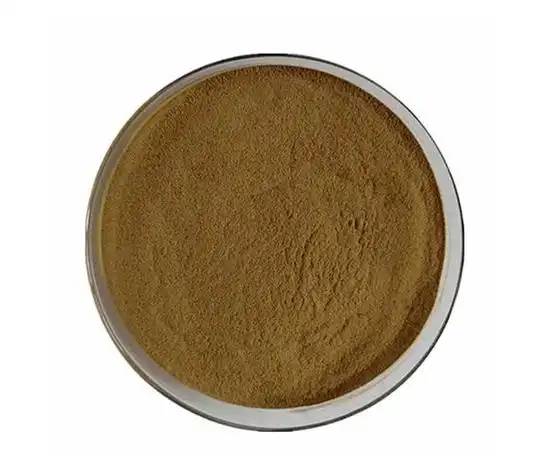
3 Biological functions of black garlic
Traditionally, garlic has been used to treat infections, gunshot wounds, diarrhea, rheumatism, heart disease, diabetes, and other physiological disorders. Experiments have found that it can also promote metabolism, lower cholesterol and triglyceride levels, and exert the effects of lowering blood lipids and blood pressure, anti-tumor, anti-bacterial, anti-aging, immune modulator and lowering blood sugar. Garlic itself is a very good health food, and black garlic is even more amazing. The chemical component of black garlic, allicin, is also known as allin, and is the general term for the main bioactive ingredients in garlic. It is mainly a sulfur-containing compound with enhanced antioxidant properties, strong bactericidal power, a wide antibacterial spectrum, and physiological effects on diabetes, anti-tumor, anti-cancer, lowering cholesterol, anti-platelet aggregation, liver protection, prevention of cardiovascular disease, lower blood pressure and other physiological effects6. At present, the main biological effects of black garlic include the following aspects.
3.1 Enhanced antioxidant properties
If there is too much active oxygen in the body, it can damage the genetic factors in cells, which can lead to cancer. In addition, active oxygen can synthesize peroxylipids in the body, which can cause premature aging and can also induce stroke, heart disease, cancer and other diseases. Experiments have shown that the antioxidant capacity of fermented garlic is 13 times that of garlic. Zhu Bingqiao et al. 7 randomly divided 144 aged mice into 9 groups: a blank group, a model group, a positive control group (Vc group), a low-dose black garlic group (65 mg/kg), a medium-dose black garlic group (260 mg/kg), a high-dose black garlic group (650 mg/kg), a low-dose white garlic group (65 mg/kg), white garlic high-dose group (650 mg/kg), etc. After creating an oxidative damage model, the malondialdehyde content in the blood and liver tissue of mice and the activities of superoxide dismutase (SOD) and glutathione peroxidase (GSH-Px) were measured. It was found that black garlic can significantly reduce the content of malondialdehyde in blood and liver tissue and increase the activity of antioxidant enzymes in the tissue. The effect of black garlic in reducing malondialdehyde content and increasing GSH-Px activity is significantly better than that of white garlic and the positive control, indicating that the antioxidant effect of black garlic is significantly better than that of white garlic.
Zhou Guangyong et al. 8 stored black garlic at 5-35°C and measured its moisture content, sugar content, total acid content and free radical scavenging capacity over time, as well as exploring the mechanism of these changes. The results showed that compared with fresh garlic, black garlic has a higher sugar and total acid content and a lower volatile organic sulfide content. The free radical scavenging capacity of black garlic is more than 8 times that of fresh garlic. During the storage of black garlic, the sugar content decreased and the total acid content increased, and the temperature coefficients Q10 were between 1.33 and 1.41 and between 1.26 and 1.32, respectively. Due to the secondary fermentation that occurred during the storage of black garlic, the maximum value of the free radical scavenging capacity could reach 69 g Trolox/kg dry matter (about 10 times the free radical scavenging capacity of fresh garlic). After 127 days of storage, the free radical scavenging capacity of black garlic was still higher than the initial value before storage.
3.2 Antibacterial and anti-inflammatory effects
Allicin and the white oily liquid allyl sulfide (CH₂CH₂CH₂-S) in black garlic are the main components that exert a bactericidal effect. They have a broad-spectrum antibacterial effect and can kill dozens of common viruses and many pathogenic microorganisms. Even when diluted 100,000 times, this allicin can instantly kill typhoid bacilli, dysentery bacilli, influenza viruses, etc. The volatile substances, leachate and allicin in black garlic have a significant inhibitory or killing effect on a variety of pathogenic bacteria in test tubes. These sulphur-containing compounds also have a strong inhibitory and killing effect on putrefactive fungi. Their effect is comparable to or even stronger than that of the chemical preservatives benzoic acid and sorbic acid. It is currently one of the most powerful antibacterial agents found in nature.9. Allicin, which is contained in black garlic, has a broad-spectrum antibacterial effect. It is effective against epidemic cerebrospinal meningitis viruses, influenza viruses, hepatitis B viruses, hepatitis viruses, the new cryptococcus that can cause severe meningitis, pneumococci, candida, tubercle bacilli, typhoid bacilli, paratyphoid bacilli, amoeba, vaginal trichomonads, rickettsia, staphylococci, shigella, vibrio cholerae, etc. [10-121].
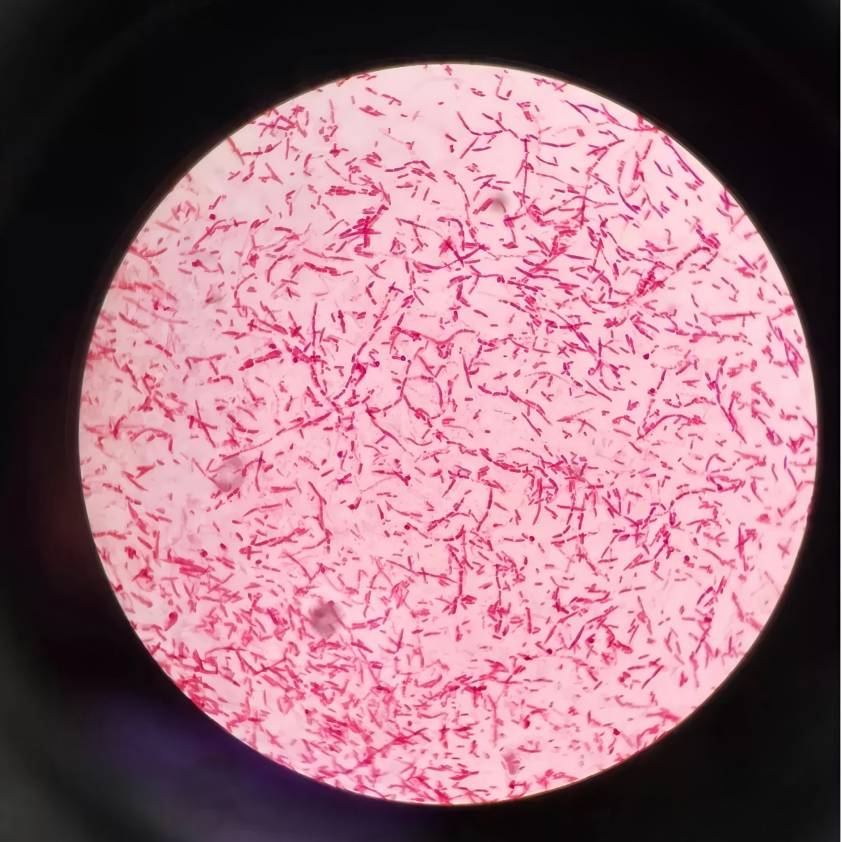
3.3 Anti-aging effect
Black garlic and its water-soluble extracts, selenium-containing proteins and selenium-containing polysaccharides have strong scavenging abilities against active oxygen free radicals such as hydroxyl radicals and superoxide radicals, and have anti-aging effects. Allinase and black garlic ethanol extracts also have a certain effect on delaying aging [3]. Previous studies have reported that 14-6 black garlic contains more amino acids, organic sulfur and S-allyl-L-cysteine than white garlic. The allicin in black garlic can also combine with lipoprotein, and after combining, it will have the function of vitamin E, that is, prevent atherosclerosis and anti-aging; vitamin B₁₅ has an antioxidant effect and which prolongs the life of cells; cystine promotes cell proliferation and detoxifies the skin; and the germanium contained in black garlic also has anti-aging effects.
3.4 Anti-cancer and anti-carcinogenic effects
Sulfur-containing compounds vary depending on the processing method (e.g. boiling, crushing, extracting or grinding). Water-soluble sulfur-containing cysteine, thiosulfates, allicin, vinyl dithiin and liposoluble propylene sulfide exist in garlic in various forms and have many biological activities, especially in cancer prevention.17 Studies have shown that ethyl mercaptosulfate and diallyl trisulfide in black garlic can inhibit the formation and accumulation of nitrosamines in the stomach in many ways, thereby inhibiting the growth of cancer cells and killing cancer cells. 18. Germanium in black garlic is a trace element with strong anti-cancer properties that can inhibit the carcinogen nitrosamine and play a role in preventing and fighting cancer. One of the main components of black garlic is allicin, which studies have shown can increase the permeability of tumor cells and cause damage to the cell membrane.
3.5 Liver protection
Black garlic can lower blood pressure, improve the symptoms of hepatitis C patients, relieve pain in the waist, shoulders and knees, restore the physical strength of patients after serious illness, alleviate the symptoms of hay fever sufferers, improve constipation in people with stubborn constipation, and reduce weight in obese people. Black garlic has strong antioxidant activity, which can inhibit the damage of lipid peroxidase to the structure of liver cell membranes and protect the liver. Studies have shown that191, the main active ingredient in black garlic is allicin, along with trace amounts of S-allylcysteine and S-methylthiocysteine. It shows good anti-hepatotoxic activity in a mouse model of hepatotoxic liver damage induced by CCl₄ and galactosamine. In addition, black garlic can enhance the activity of glutathione S-transferase in liver cells and improve the detoxification function of the liver. L-Methionine in black garlic can also prevent and treat chronic and acute hepatitis, cirrhosis and other liver diseases; branched-chain amino acids such as valine have a good therapeutic effect on liver failure; and alanine and aspartame can enhance liver function and protect the liver.
Jung et al. (by feeding high-fat food to obese rats, measured the biological activity and in vitro antioxidant activity of fermented black acid, and found that fermented black garlic is more antioxidant than garlic. Therefore, they hypothesized that garlic enhances its antibacterial activity through yeast fermentation, and that it will become a good functional nutritional food for enhancing the oxidative defense system in the elderly with diabetes and diabetes complications. To verify this hypothesis, the biological activity of fermented black garlic was measured in diabetic and obese mice, and its in vitro antioxidant activity was also measured. The mice were fed a high-fat diet for 91 days, and they showed significant obesity, hyperglycemia, hypertension, and liver and kidney damage. Compared to the control high-fat diet, black garlic and fermented black garlic at three different doses showed good liver protection, blood lipid lowering and anti-obesity effects. The test also found that the fermented black garlic group had more biological activity than the black garlic group at the same dose. These findings show that the biological activity of black garlic can be enhanced by fermentation.
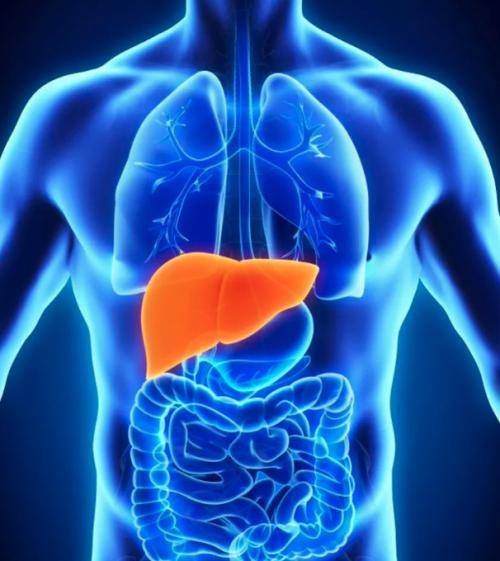
3.6 Treatment of hypertension and cardiovascular and cerebrovascular diseases
Ried et al. 12 showed that black garlic extract is superior to antihypertensive drugs in assisting blood pressure reduction. Ao et al. 2 found that dietary supplementation with black garlic powder has a positive effect on cholesterol metabolism. High levels of low-density lipoprotein (LDL) and total cholesterol can lead to atherosclerosis and cardiovascular disease. In the experiment, the addition of black garlic powder to the diet significantly inhibited the synthesis of cholesterol in the body, so it is of great help in the treatment of cardiovascular diseases.
3.7 Regulates blood sugar levels
Black garlic can affect the synthesis of glycogen in the liver, lower blood glucose levels and increase plasma insulin levels. The ability of black garlic to regulate blood sugar is not simply control, but rather the protection of insulin, actively converting sugar into energy, so that diabetic patients have the same sugar-converting ability as ordinary people, rather than lowering blood sugar with medication. Therefore, black garlic has an effect that is comparable to that of non-ordinary blood sugar-lowering products.
Allicin in black garlic can lower blood sugar levels in healthy people. Black garlic also contains S-methylcysteine sulfoxide and S-allylcysteine sulfoxide, which are sulfide compounds that inhibit G-6-P enzyme NADPH and prevent insulin damage, thus lowering blood sugar. Allyl disulfide in black garlic also has this effect. In addition, the alkaloids contained in black garlic also have the effect of lowering blood sugar, increasing insulin function, and more importantly, having no effect on normal blood sugar levels. Glycine can lower blood sugar levels and prevent diabetes. Isoleucine has the function of promoting insulin secretion and regulating blood sugar. Researchers fed 25 g of black garlic juice to rabbits in an animal experiment to conduct a glucose tolerance test.121 The maximum blood glucose reduction in the black garlic group was 12.4% ± 1.2%, while the distilled water control group was 1.8% ± 0.5%, indicating that black garlic has a significant effect on blood glucose control. They also gave oral black garlic extract to rats with diabetes caused by alloxan, and the results also showed that black garlic has a hypoglycemic effect, with blood glucose concentrations reduced by 17.9% to 26.2% 2 hours after ingestion.
3.8 Enhances immune function
Allicin has the function of activating cell membranes composed of glycolipids, increasing their permeability, enhancing cell metabolism, improving vitality, and strengthening the body's immune system. Experiments have shown that the liposoluble volatile oil in black garlic can significantly improve the phagocytic function of macrophages and enhance the immune system.12 Lysine and serine both have the function of improving immunity, and vitamin C can also enhance the body's immunity. Zinc contained in black garlic can participate in the synthesis of hormones and improve the body's immunity. Ethyl carbamate is derived from ethyl carbamate, a chemical found in alcoholic beverages and fermented foods.
Feng Yonghui et al. 24 studied the effect of black garlic extract on the cellular immune function of BALB/c mice. The results showed that black garlic extract can significantly enhance the killing activity of NK cells and promote the secretion of NO and Th1 cytokines L-2, IFN-γ and TNF-α. The level of IL-4 was slightly reduced, indicating that black garlic extract has a certain promoting effect on the cellular immune response of mice. Animal experiments have shown that the fat-soluble volatile oil in black garlic can significantly enhance the phagocytic function of macrophages and has the effect of strengthening the immune system.
Liu et al. 125 found that garlic oil has a dual effect on the balance of Th1/Th2 cytokines. A low dose can enhance the Th1 T cell immune response, while a high dose can enhance the Th2 cellular immune response. Allicin has the effect of inducing human lymphocytes, and as the concentration of allicin increases, the frequency of lymphocyte activity also increases, indicating that allicin can enhance human immunity. Foreign scholars have proved through experimental studies that allicin has varying degrees of influence on the chemotaxis, phagocytosis and killing of neutrophils. Relevant studies have shown that allicin can increase the number of antibody-forming cells in the spleen of mice and significantly enhance the humoral immune function of animals. It can be seen that black garlic can significantly improve the body's cellular immune function, humoral immune function and non-specific immune function, and enhance the body's immunity.
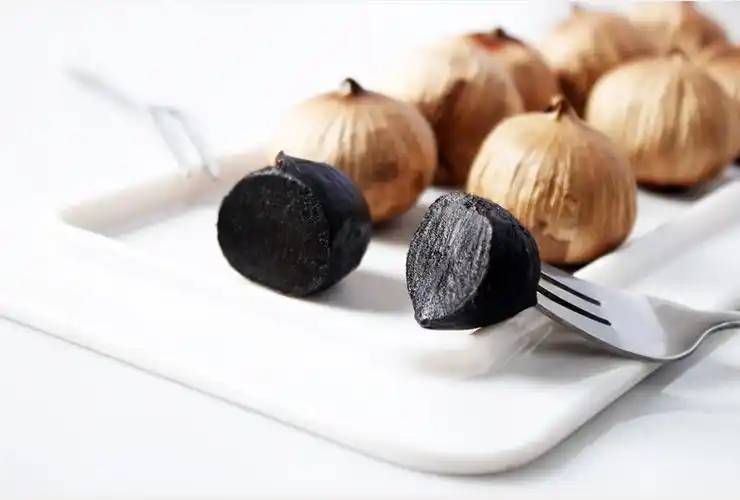
4 Conclusion and outlook
In short, black garlic, as a healthy food, has a complementary and alternative role in tumor prevention and treatment. While inhibiting tumors, it also has the functions of improving the body's immunity, anti-oxidation, scavenging free radicals, lowering blood lipids and blood sugar, and other multi-directional regulatory functions, which is in line with the concept of “treating diseases before they occur” advocated by traditional Chinese medicine. Black garlic is gradually attracting widespread attention and has broad prospects for clinical application. However, there is still little basic research on the anti-tumor mechanism of black garlic and its effective monomer components. It is urgent to strengthen the research on black garlic in a scientific way to benefit cancer patients as soon as possible. However, there are still some unresolved problems. For example, in the study of the anti-tumor mechanism, it is difficult to find a common target. It is not yet known how the anti-tumor activity of these organic sulfur compounds in garlic can be applied in the clinic. It is believed that through continuous in-depth research on the mechanism of black garlic's activity, people will discover that black garlic will have a greater effect on human health and the prevention and treatment of diseases.
Reference:
[1]AvielloG,AbenavoliL,BorrelliF,et al.Garlic:empiricism or science[J].Nat Prod Commun,2009,4(12):1785-1796.
[2]Koch HP,Laws on L D.Garlic:the science and therapeutic application of Allium sativum L and related species[M].Baltimore: Williams &Wilkins,1996,37-107.
[3] Wang Xin, Yang Ke, Wang Yishan. Research progress on the role of black garlic in tumor prevention and treatment [J]. Journal of Practical Medicine, 2011, 28(2): 176-178.
[4]Sato E,Kohno M,Hamano H,et al.Increased antioxidative potency of garlic by spontaneous short-term fermentation[J].Plant Foods HumNutr,2006,61:157-160.
[5]Wang YB,Qin J,Zheng XY,et al.Diallyl trisulfide induces Bcl-2 and caspase-3-dependent apoptosis via downregulation of Akt Phosphorylation in human T24 bladder caneer cells [J]. Phytomedieine,2010:17(5):363-368.
[6]Bakri IM,Ouglas CW.Inhibitory effect of garlic extract on oral bacteria[J].Areh Oral Biol,2005,50(7):645.
[7] Zhu Bingqiao, Wu Haige, Liu Yuanyuan, et al. Research on the antioxidant activity of black garlic [J]. Food Research and Development, 2008, 29(10): 58-60.
[8] Zhou Guangyong, Miao Yanshu, Chen Jieyu, et al. Changes in the main components and free radical scavenging capacity of black garlic during storage [J]. Chinese Journal of Food Science, 2010, 10(6): 64-71.
[9]Sato E,Niwano Y,Kohno M.Fermented garlic a novel candidate food for the prevention of diabetic nephropathy[C].OCC'2010 World Congress-Book of Abstracts,2010.
[10]Pedraza-ChaverriJ,Medina-Campos ON,Avila-Lombardo R,et al.Reactive oxygen species scavenging capacity of different cooked garlic preparations[J].Life Sciences,2006,78(7):761-770.
[11]Zulueta A,Esteve M,Frgola A.ORAC and TEAC assays comparison to measure the antioxidant capacity of food products [J].Food Chemistry,2009,114(1):310-316.
[12]Kodera Y,Suzuki A,et al.Physical chemical and biological properties of S-allyleysteine,an amino acid derived from garlic [J].JAgric Food Chemistry,2002,50(3):622-632.
[13]Das I,Saha T.Effect of garlic on lipid peroxidation and antioxidation enzymes in DMBA-induced skin carcinoma[J]. Nutrition,2009,25(4):459-471.
[14]Iberl B,Winkler G,et al.Products of allicin transformation: Ajoenes and Dithiins,characterization and theirdetermination by HPLC[J].Planta Medica,1990,56(2):202-211.
[15]Re R,Pellegrini N,Proteggente A,et al.Antioxidant activity applying an improved ABTS radical cationdecolorization assay[J]. Free Radical Biology and Medicine,1999,26(9-10):1231-1237. [16]Sasaki J,Ch LU,Machiya E,et al.Processed black Garlic (allium sativum)extracts enhance anti-tumor potency against mouse tumors[J].Med Aroma J Plant Sci Biotech,2007,1(2): 278-281.
[17]Hernandez LG,Forkert PG.Inhibition of vinyl carbamate- induced lung tumors and Kras2 mutations by the garlic derivative diallyl sulfone[J].Mutation Research,2009,662(1-2):16-21
[18]Hernandez LG,Forkert PG.Inhibition of vinyl carbamate- induced mutagenicity and clastogenicity by the garlic constituent diallyl sulfone in F1(Big Blue x A/J)transgenic mice[J]. Carcinogenesis,2007,28(2):1824-1830.
[19]Eidi A,Eidi M,Esmaeili E.Antidiabetic effect of garlic (Allium sativum L)in normal and streptozotocin -induced diabetic rats[J].Phytomedicine,2006,13(9-10):624-629.
[20]Jung YM,LeeSH,Lee DS,et al.Fermented garlic protects diabetic,obesemice when fed a high-fatdiet by antioxidant effects [J].Nutrition Research,2011,31(5):387-396.
[21]Ried K,Frank OR,Stocks N P.Aged garlic extract lowers blood pressure in patients with treated but uncontrolled hypertension:A randomised controlled trial[J].Maturitas,2010,67
(2):144-150.
[22]Ao X,Yoo JS,Zhou TX,et al.Effects of fermented garlic powder supplementation on growth performance,blood profiles and breast meat quality in broilers[J].Livestock Science,2011, 141(1):85-89.
[23]Sankaranarayanan A,Narender T,Kumar S,et al. Alliumsativum constituents:effect on free radical generation from rat neutrophils[J].Cell Mol Biol(Noisylegrand),2007,53(5):63-67.
[24] Feng Yonghui, Wang Qinghui, Wang Meiru, et al. Preliminary study on the effect of black garlic extract on the immune response of mouse cells [J]. Chinese Journal of Immunology, 2010, 26(11): 982-985.
[25]Liu CT,Su HM,LiCK,et al.Effect of supplementation with garlic oil on activity of Th1 and Th2 lymphocytes from rats [J].Planta Med,2009,75(3):205-210.


 English
English French
French Spanish
Spanish Russian
Russian Korean
Korean Japanese
Japanese